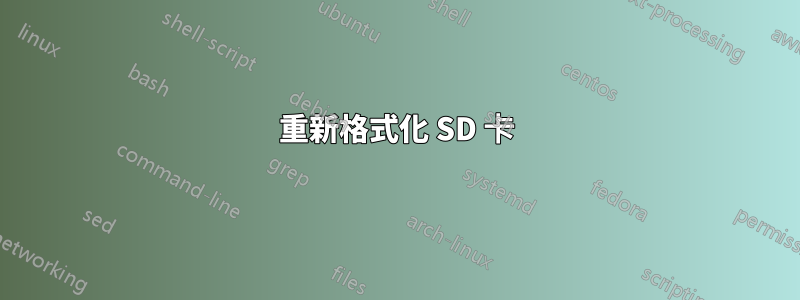
我需要將 SD 卡重新格式化回出廠狀態。
用於媒體的 SD 卡檔案系統已損壞。存取某個目錄會導致檔案系統以唯讀方式重新掛載,且無法刪除。 fsck.vfat 表示它沒有針對特定類型損壞的修復方法。
答案1
提醒:這樣的命令旨在覆蓋檔案系統資料。您必須格外小心,以避免定位錯誤的磁碟。
編輯:
在格式化卡片之前,您可能還需要執行丟棄操作。
blkdiscard /dev/mmcblk0
這可能會提高效能 - 與 SATA SSD 上的 TRIM 相同。重置區塊重新映射層理論上也可能有助於解決該層或周圍的損壞,儘管此方法不如專用的完整設備擦除命令(SATA 安全擦除)。並非所有讀卡機都支援此功能。在我的 Dell Latitude 筆記型電腦上,它在一秒鐘內將卡片重置為全零。這意味著在這張卡上它只影響區塊重映射層;它無法立即擦除整個 16GB 快閃記憶體。
MicroSD 卡包含一個或多個快閃記憶體晶片和一個小型微處理器,可作為 SD 卡規格和快閃記憶體晶片之間的介面。卡通常在工廠格式化以獲得接近最佳的性能。但是,大多數作業系統預設分割區和格式化實用程式將這些卡視為傳統硬碟。適用於傳統硬碟的方法會導致快閃記憶體卡的效能和使用壽命下降
http://3gfp.com/wp/2014/07/formatting-sd-cards-for-speed-and-lifetime/
腳本可用於最大 32GiB 的卡片。我已將其修改為與當前版本的sfdisk.在產生的分割區上執行file -s傳回的數字與之前相同,但每個磁軌的磁頭/磁區數除外。目前作業系統不使用這些值,儘管顯然某些嵌入式引導程式需要特定值。
#! /bin/sh
# fdisk portion of script based on mkcard.sh v0.4
# (c) Copyright 2009 Graeme Gregory <[email protected]>
# Additional functionality by Steve Sakoman
# (c) Copyright 2010-2011 Steve Sakoman <[email protected]>
# Updated by Alan Jenkins (2016)
# Licensed under terms of GPLv2
#
# Parts of the procudure base on the work of Denys Dmytriyenko
# http://wiki.omap.com/index.php/MMC_Boot_Format
# exit if any command fails
set -e
export LC_ALL=C
format_whole_disk_fat32() {
if ! id | grep -q root; then
echo "This utility must be run prefixed with sudo or as root"
return 1
fi
local DRIVE=$1
# Make sure drive isn't mounted
# so hopefully this will fail e.g. if we're about to blow away the root filesystem
for mounted in $(findmnt -o source | grep "^$DRIVE") ; do
umount "$mounted"
done
# Make sure current partition table is deleted
wipefs --all $DRIVE
# Get disk size in bytes
local SIZE=$(fdisk -l $DRIVE | grep Disk | grep bytes | awk '{print $5}')
echo DISK SIZE – $SIZE bytes
# Note: I'm changing our default cluster size to 32KiB since all of
# our 8GiB cards are arriving with 32KiB clusters. The manufacturers
# may know something that we do not *or* they're trading speed for
# more space.
local CLUSTER_SIZE_KB=32
local CLUSTER_SIZE_IN_SECTORS=$(( $CLUSTER_SIZE_KB * 2 ))
# This won't work for drives bigger than 32GiB because
# 32GiB / 64kiB clusters = 524288 FAT entries
# 524288 FAT entries * 4 bytes / FAT = 2097152 bytes
# 2097152 bytes / 512 bytes = 4096 sectors for FAT size
# 4096 * 2 = 8192 sectors for both FAT tables which leaves no
# room for the BPB sector
if [ $SIZE -ge $(( ($CLUSTER_SIZE_KB / 2) * 1024 * 1024 * 1024 )) ]; then
echo -n "This drive is too large, >= $(($CLUSTER_SIZE_KB / 2))GiB, for this "
echo "formatting routine."
return 1
fi
# Align partitions for SD card performance/wear optimization
# Summary: start 1st partition at sector 8192 (4MiB) and align FAT32
# data to start at 8MiB (4MiB logical)
# There's a document that explains why, but its too long to
# reproduce here.
{
echo 8192,,0x0C,*
} | sfdisk -uS -q $DRIVE
sleep 1
if [ -b ${DRIVE}1 ]; then
PART1=${DRIVE}1
elif [ -b ${DRIVE}p1 ]; then
PART1=${DRIVE}p1
else
echo "Improper partitioning on $DRIVE"
return 1
fi
# Delete any old filesystem visible in new partition
wipefs --all $PART1
# Format FAT32 with 64kiB clusters (128 * 512)
# Format once to get the calculated FAT size
local FAT_SIZE=$(mkdosfs -F 32 -s $CLUSTER_SIZE_IN_SECTORS -v ${PART1} | \
sed -n -r -e '/^FAT size is/ s,FAT size is ([0-9]+) sectors.*$,\1,p')
# Calculate the number of reserved sectors to pad in order to align
# the FAT32 data area to 4MiB
local RESERVED_SECTORS=$(( 8192 - 2 * $FAT_SIZE ))
# Format again with padding
mkdosfs -F 32 -s $CLUSTER_SIZE_IN_SECTORS -v -R $RESERVED_SECTORS ${PART1}
# Uncomment to label filesystem
#fatlabel ${PART1} BOOT
}
#set -x
format_whole_disk_fat32 "$@"


